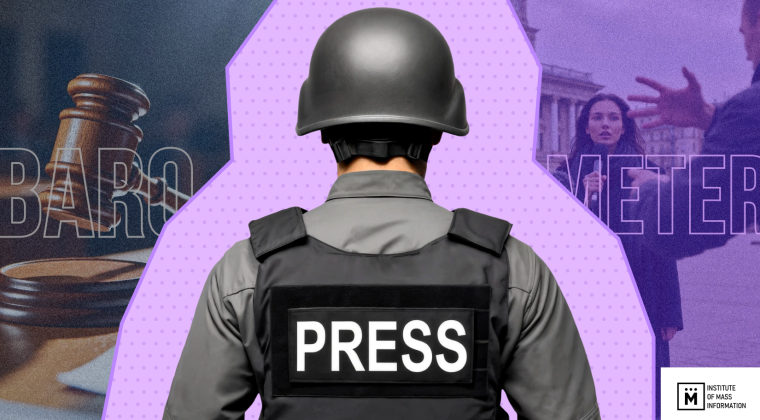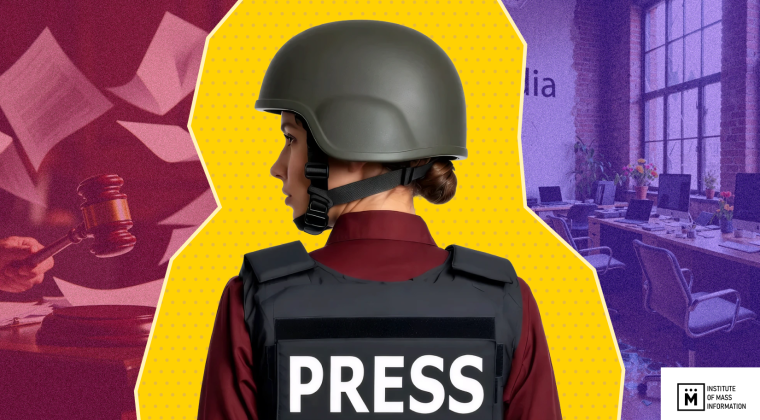Has Russia lied before? Let us recap. Take a few examples from the past ten years of the Russo–Ukrainian war. For instance, the MH17 plane being shot down over the occupied Donbas in July 2014, killing 298 people. The Russians blamed Ukraine for this. Yet, years later, the Dutch court ruled that the missile was launched from the territory which was not under Ukraine’s control.
Or take the mass murder of Ukrainian prisoners of war in Olenivka in July 2022 — a missile destroyed part of the prison where the Mariupol defenders were held, killing over 50 soldiers. The Russians immediately declared that the missile was fired from a HIMARS – a system that had recently become available to the Ukrainian army. Later, the UN reported that it was definitely not HIMARS. We believe there is no need to explain that it was not a Ukrainian missile at all.
So yes, Russia has lied.
Is the Western media aware of it? Certainly. However, they stubbornly continue to promote Russian claims, at best using “Russia claims” or “cannot yet verify” as a fig leaf.
The fall of the IL-76, the fall of the Western media standards
A recent example: on January 24, around 10:00 a.m. Kyiv time, an IL-76 transport plane crashed near the Russian Belgorod city, not too far from Ukraine’s border.
At around 11:00 a.m., a video filmed by an eyewitness enters Ukrainian social media: the plane crashing into the ground and exploding.
Video shared by war_monitor on Telegram
“Ukrainian Pravda” and RBC-Ukraine are quick to report on the news, quoting their own sources as saying that the plane was shot down by the Ukrainian army because it was carrying missiles for the air defense system S-300 (the day before, the Russian troops had brutally shelled Kharkiv, which is close to Belgorod).
At once, a rumour of unknown origin starts spreading that there were 63 people on board and all of them died. The 63 people almost immediately become 65 Ukrainian POWs supposedly transported on this plane by Russia for a swap. They were all “killed by a Ukrainian missile.”
The UP and RBC edit the news about Ukraine’s involvement in the crash, saying that other sources do not confirm this. The UP editor-in-chief, Sevgil Musaieva, explained in a comment to “Detector Media” that they initially received information about the plane being shot down by the UAF from the General Staff. Later, sources from the Defense Intelligence were unable to confirm this, which is why the team decided to update the headline.
It would not be very fair to blame the Ukrainian media for not verifying the information they received from sources in their own army while this army keeps us all physically safe.
The most disappointing were the world-famous news websites in English, which posted Russia’s claims on 65 killed POWs with no verification.
This is what the first page in Google search looked like on January 24 at noon.
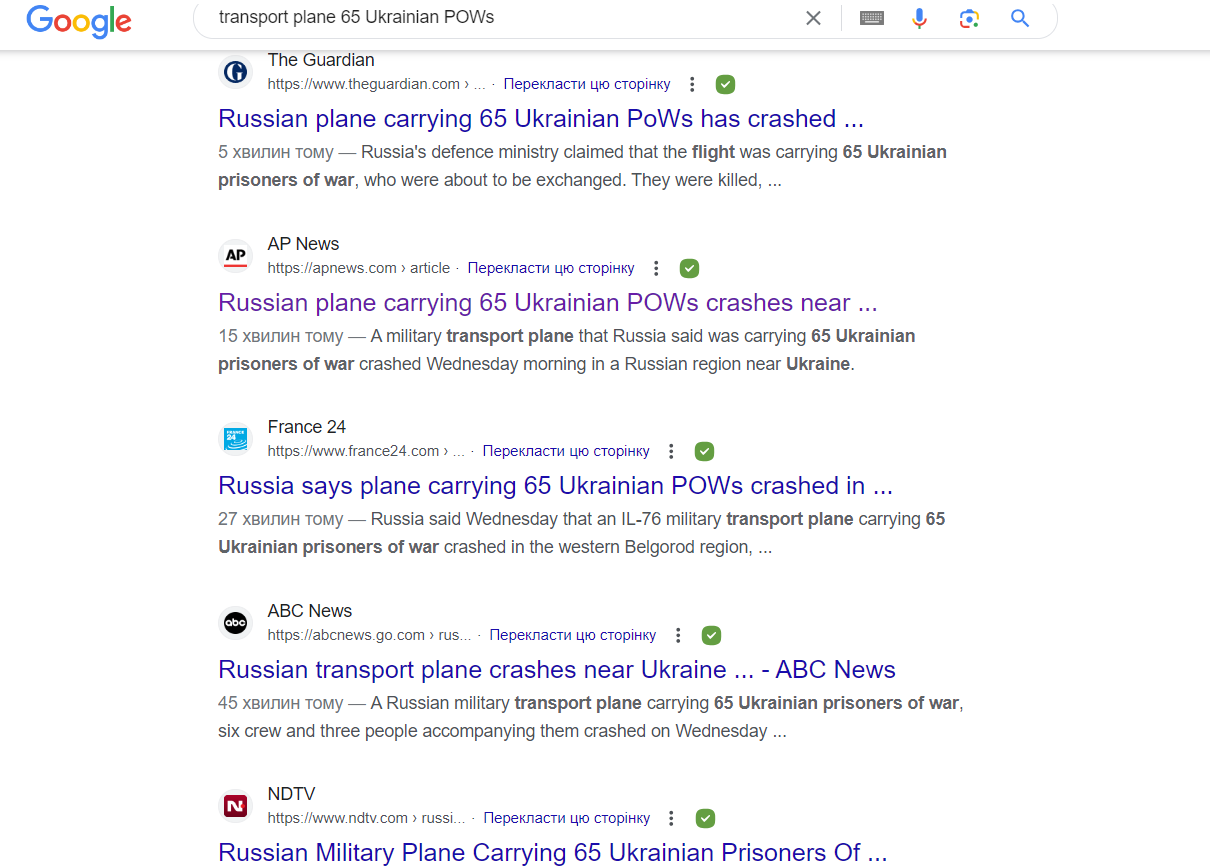
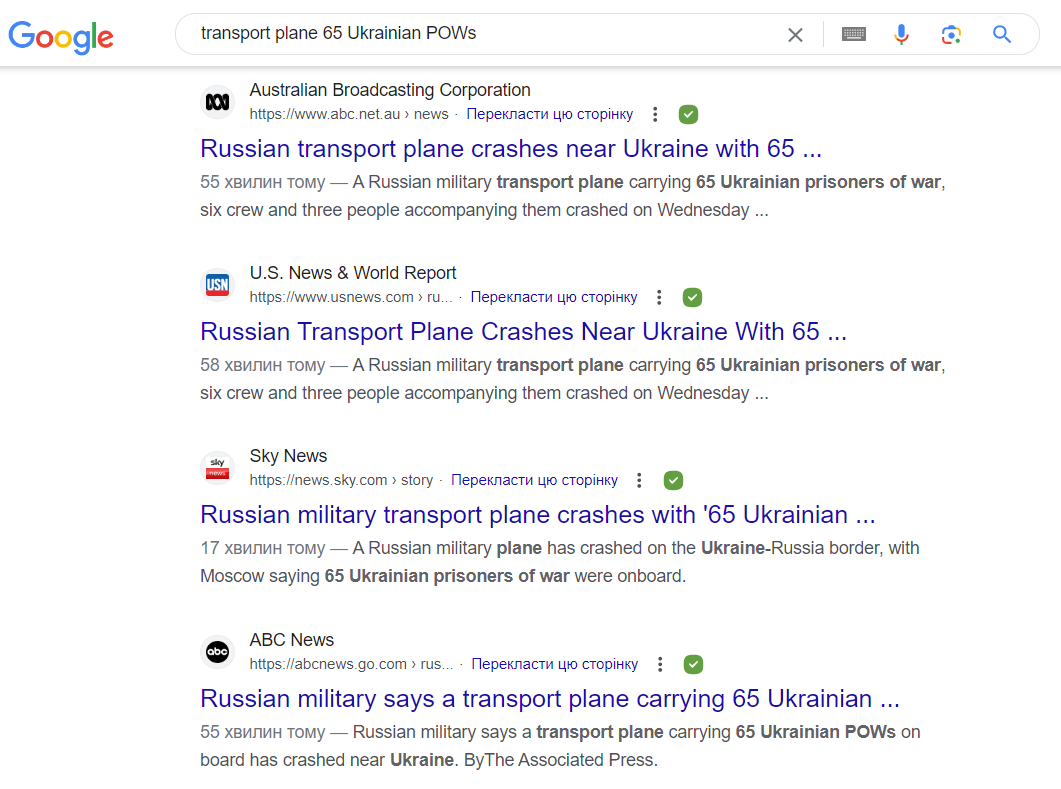
Screenshots by the IMI
Heroes of the day:
- Associated Press (Russia says a transport plane has crashed and that 65 Ukrainian POWs were on board)
- The Guardian (Russian plane carrying 65 Ukrainian PoWs has crashed, Moscow says)
- France 24 (Plane carrying 65 Ukrainian POWs crashes in Belgorod border region, Russia says)
- ABC News (Russia says a transport plane has crashed and that 65 Ukrainian POWs were on board)
- Australian Broadcasting Corporation (Russian transport plane crashes near Ukraine with 65 Ukrainian POWs on board)
- US News (Russian Transport Plane Crashes Near Ukraine With 65 Ukrainian POWs on Board)
- Sky News (Russian military transport plane crashes with ’65 Ukrainian PoWs onboard’)
- BBC (Russian plane carrying 65 Ukrainian PoWs has crashed, Moscow says)
- Reuters (Russian plane crashes with Ukrainian POWs on board – RIA cites defence ministry)
This is only the news from the top of the search.
The gist of these reports is as follows: “Russia says that the crashed plane was carrying Ukrainian POWs and Ukraine shot it down with Western weapons. They provide no evidence, Ukraine gives no comments on the situation, and we can not verify anything.”
Still, the media outlets had no problem including these unverified and potentially false claims in the headlines of their news.
If you follow the links, you will see that some headlines or even whole news stories have been updated, mellowed down. This happens when editors do not care to check the information from sources that have discredited themselves many times.
What was Russia doing in the meantime?
The Kremlin propaganda fully embraced this narrative and channeled it everywhere. Pro-Russian Telegram channels took a liking to screenshots from “Ukrainian Pravda” and RBC-Ukraine, which, as per propagandist Olga Skabeyeva, prove that “the Ukrainians shot down their own people.”

Headlines: “IL-76 shot down over Russia’s Belgorod region: UAF says it is ‘their work'” / “IL-76 military plane falls down over Russia’s Belgorod region”
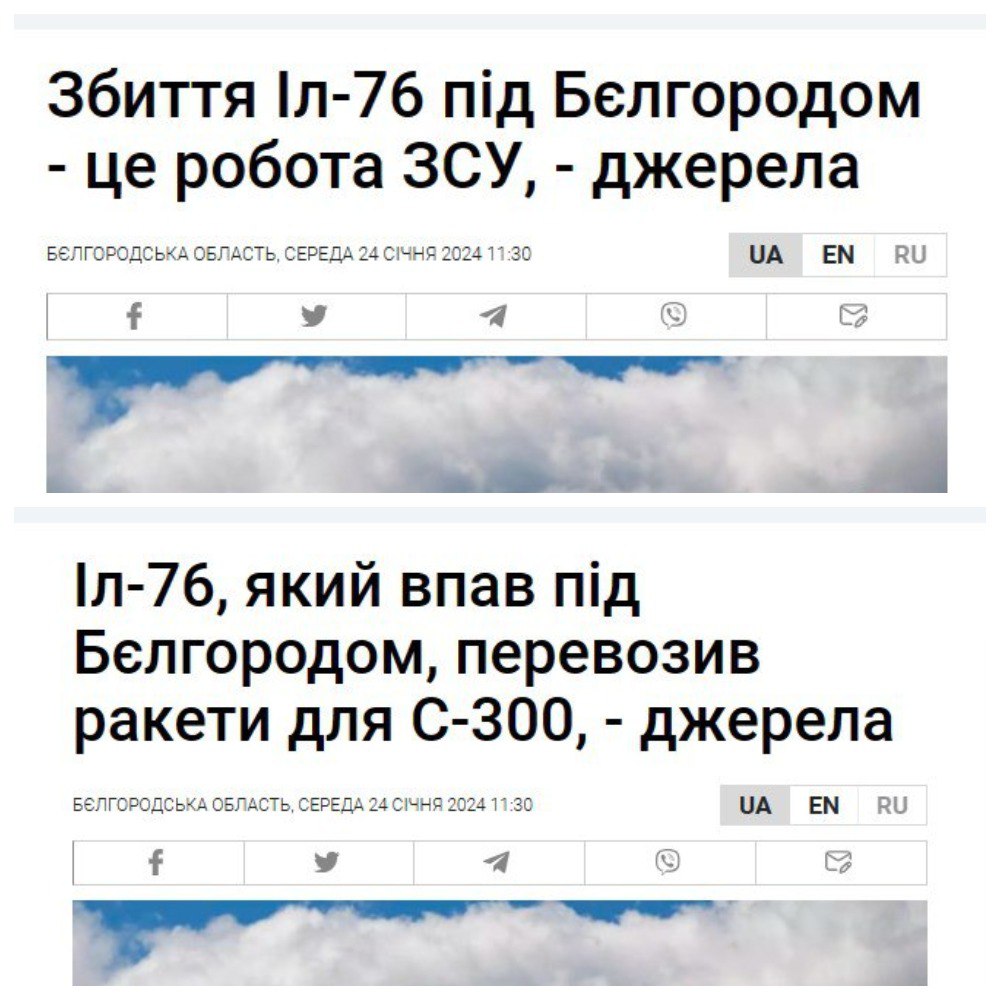
Headlines: “The IL-76 shot down over Belgorod is the UAF’s work, sources say” / “The IL-76 that fell down near Belgorod was carrying S-300 missiles, sources say”
Screenshots by the IMI
Her colleague Margarita Simonyan is very concise about the whole thing. At 11:44 a.m., she wrote that the plane and the crew were Russian, the POWs were Ukrainian, and that the plane was shot down by Ukraine as well. After 2:00 p.m., she posted a supposed list of 65 prisoners who were on board.
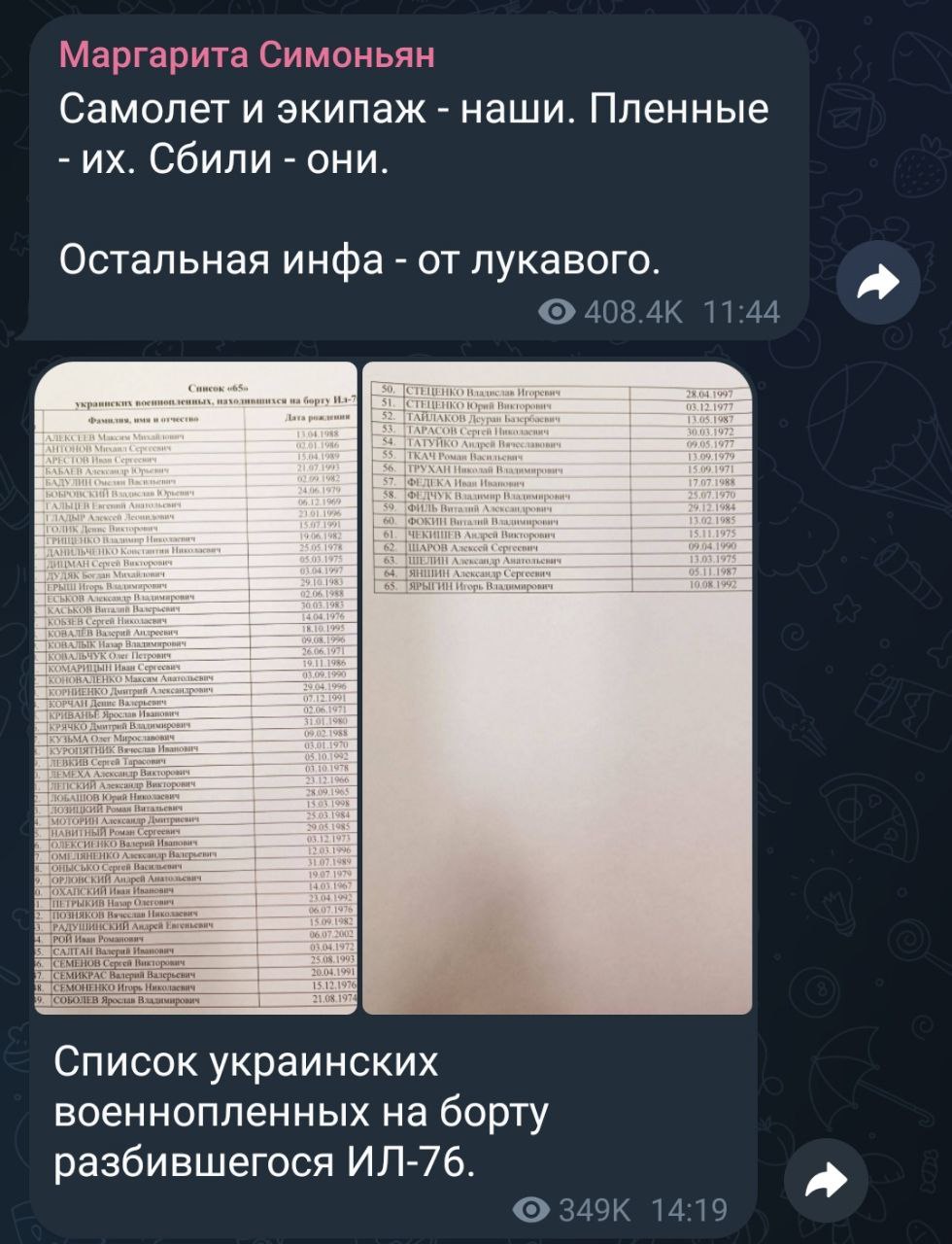
“The plane and the crew were ours. The POWs were theirs. It was them who shot it down. All other information is the Devil’s work.” / “The list of Ukrainian POWs on board the crashed IL-76.”
Screenshot from Margarita Simonyan’s Telegram channel by the IMI.
While Simonyan was silent, Skabeyeva was quick to promote the statement by the Russian Duma speaker, Vyacheslav Volodin, who said the following:
“Let us prepare an address to the US Congress and the German Bundestag so that the MPs can at last see whom they are funding. This is the Nazi regime nurtured by Biden, Scholz, and Macron. They shot their soldiers down from the sky, their own.”
The propagandist also shared the statement by the deputy chair of Russia’s Security Council, Dmitri Medvedev: “The IL-76 plane crash is the result of the internal political strife among the neo-Nazi elites in Kyiv” (we have already discovered that claims about supposed discord within the Ukrainian government, in particular, a conflict between President Zelensky and Commander-in-Chief Zaluzhny, have been a key talking point in Russian propaganda in recent months).
In the meantime, Skabeyeva rejoiced over the aforementioned reports in the Western media, which did the Russians a great favour.

“‘Ukrainian POWs were on board Russian military plane that crashed in Belgorod region’ – The Guardian decided it was better to trust Russia’s information than Kyiv’s claims about S-300 ammo deliveries.”
Screenshot by the IMI
All of the above statements, in various combinations, flooded Telegram, Twitter (now X) and other social media platforms. An information campaign pushing such ideas as “here’s what your Western weapons have led to” and “there will be no more swaps” has begun.
Something does not check out
- The Russians only published what could be considered real evidence of their accusations – photos and videos from the crash site – in the evening. We will not share these images and footage out of ethical considerations, but they do not show any body parts of the dozens of people, only a few blurred red blots. What prevented the Russians from substantiating their claims with photo and video arguments right after the plane crash is a rhetorical question.
- Russia claims that there were six crew members and three guards on board. The death of at least three of them has been confirmed by their relatives, RFE/RL discovered. Interestingly enough, the propagandists posted the lists of Ukrainians almost immediately, and the search for the crew began later that day – such were the priorities.
- The site of the crash was sealed off right away and no one was allowed to enter it. The Russian Telegram channel “Baza” wrote that the plane wreckage was scattered around within the 5 km diameter, and the bodies within 2 km from the crash spot. How did this happen, if the plane did not explode in the air, but upon hitting the ground (see the video above)?
- The Russians have also said that the plane was followed by another IL-76 carrying 80 more people for the swap, but it turned back. The swap was supposed to be 192 for 192. However, these reports only amount to 145 soldiers (65 + 80). It is unclear where the rest is, and Russia gives no explanation.
- The sheet with the POWs’ names is titled “List of the 65 Ukrainian prisoners of war who were on board the IL-76”. In the past tense. Which begs the question why the list was compiled after the plane was shot down, and not before the people who were supposedly being taken for a swap embarked.
- The sheet includes the name of a soldier from the list of prisoners who were swapped on January 3 – Maksym Konovalenko. Russia says that he was not exchanged back then, and was being taken for a swap on that day. It is unclear whether he was swapped on January 3.
- The soldier Maksym Kolesnikov, who came back from captivity in February 2023 and whose photo with an apple impressed the whole world, does not believe that 65 Ukrainian soldiers could have been transported accompanied by only three guards. After all, their group of 50 people was accompanied by twenty guards.
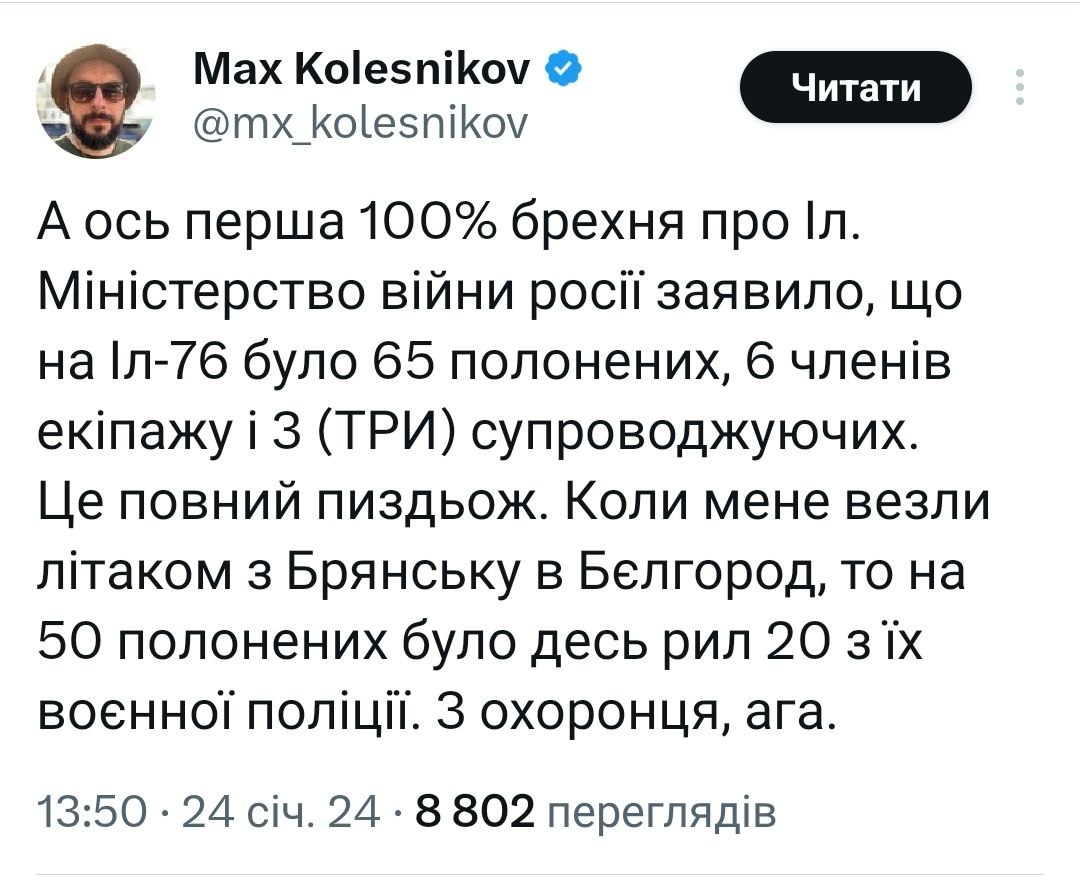
“Here goes the first 100% lie about the IL. Russia’s war ministry claims that there were 65 POWs, 6 crew members and 3 (THREE) guards. This is total bullshit. When I was being moved from Bryansk to Belgorod by plane, they had some 20 military police guys per 50 POWs. 3 guards, sure.”
Screenshot by the IMI
What about Ukraine, though?
Ukraine was silent. Which is why it failed to balance out the Russian claims which flooded the English-language media space.
In the afternoon, Andriy Yusov, a Defense Intelligence representative, said in a comment to Radio Liberty that a POW swap between Russia and Ukraine was indeed supposed to take place on January 24. However, it is unclear whether the Ukrainian soldiers could have been on the IL-76 plane.
Meanwhile, the Coordinating Headquarters for the Treatment of Prisoners of War urged people not to share unverified information about the IL-76 crash before all the relevant data is collected and analyzed.
In the evening, the General Staff made a statement from which little was clear, except that the Armed Forces would keep exterminating all aircraft that terrorize Ukraine, particularly from the Belgorod area.
The UAF intelligence department wrote on Telegram that “Ukraine was not informed of the need to ensure safe airspace in the Belgorod area for a certain period of time, as has been done repeatedly in the past.” Which is not very specific, either.
You can not comment clearly on something you know nothing about. Only Russia has access to the crash site and the people involved; therefore, neither Ukraine nor, most likely, international organizations (who were never allowed in Olenivka) will have it. Russia has a complete monopoly on the newsmaker event that it itself manufactured. All consumers of this information are hostages to Russia.
Maybe the same Ukrainian statement would have helped a little, had it been released five hours earlier. Still, only a little, because honesty about the lack of information will never overpower blatant lies in a world where liars are a relevant source of information for the credible media.
The Institute of Mass Information (IMI) is a public media organization that has been operating since 1995. The IMI defends the rights of journalists, analyzes the media field and covers media-related events, fights propaganda and disinformation and has been providing media outlets with safety gear for trips to the combat zone since the start of the Russo–Ukrainian war in 2014.
The IMI carries out Ukraine’s only freedom of speech monitoring and keeps a list of high quality and sustainable online media outlets, documents Russia’s crimes against the media committed in the course of the war on Ukraine. The IMI has representatives in 20 oblasts of Ukraine and a network of “Mediabaza” hubs to provide journalists with continuous support. The IMI’s partners include Reporters Without Borders and Freedom House; the organization is a member of the International Organization for the Protection of Freedom of Expression (IFEX).
Hanna Chabarai, media expert at the Institute of Mass Information

